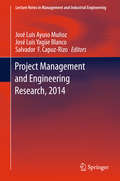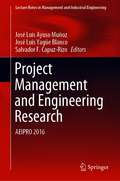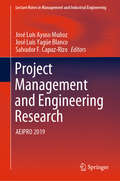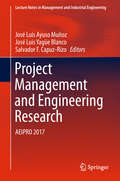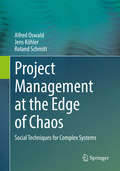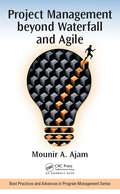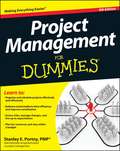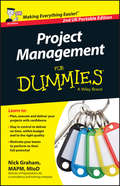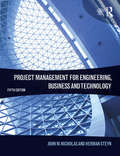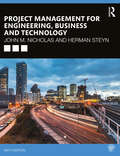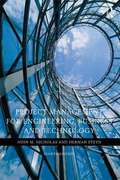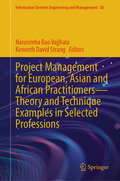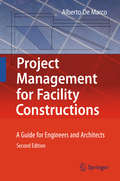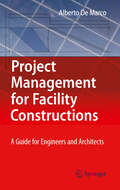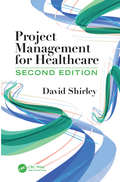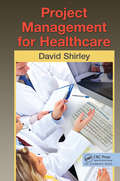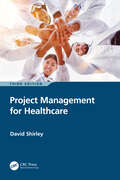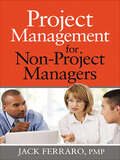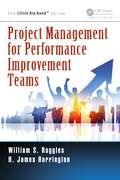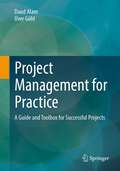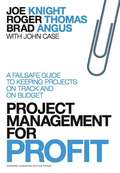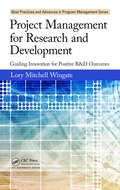- Table View
- List View
Project Management and Engineering Research, 2014
by José Luis Ayuso Muñoz José Luis Yagüe Blanco Salvador F. Capuz-RizoThis volume features papers from the 18th International Congress on Project Management and Engineering, held by the University of Zaragoza in collaboration with the Spanish Association of Project Management and Engineering (AEIPRO). It illustrates the state of the art in this emerging area. Readers will discover ways to increase the effectiveness of project engineering as well as the efficiency of project management. The papers, written by international researchers and professionals, cover civil engineering and urban planning, product and process engineering, environmental engineering, energy efficiency and renewable energies, rural development, safety, labor risks and ergonomics, and training in project engineering. Overall, this book contributes to the improvement of project engineering research and enhances the transfer of results to the job of project engineers and project managers around the world. It will appeal to all professionals in the field as well as researchers and teachers involved in the training of future professionals.
Project Management and Engineering Research: AEIPRO 2016 (Lecture Notes in Management and Industrial Engineering #0)
by José Luis Ayuso Muñoz José Luis Yagüe Blanco Salvador F. Capuz-RizoThis book gathers the best papers presented at the 19th International Congress on Project Management and Engineering, which was held in Granada, Spain in July 2015. It covers a range of project management and engineering contexts, including: civil engineering and urban planning, product and process engineering, environmental engineering, energy efficiency and renewable energies, rural development, information and communication technologies, safety, labour risks and ergonomics, and training in project engineering.Project management and engineering is taking on increasing importance as projects continue to grow in size, more stakeholders become involved, and environmental, organisational and technological issues become more complex. As such, this book offers a valuable resource for all professionals seeking the latest material on the changing face of project management.
Project Management and Engineering Research: AEIPRO 2019 (Lecture Notes in Management and Industrial Engineering #0)
by José Luis Ayuso Muñoz José Luis Yagüe Blanco Salvador F. Capuz-RizoThis book gathers the best papers presented at the International Congress on Project Management and Engineering, in its 2017 and 2018 editions, which were held in Cádiz and Madrid, Spain. It covers a range of topic areas, including civil engineering and urban planning, product and process engineering, environmental engineering, energy efficiency and renewable energies, rural development, information and communication technologies, and risk management and safety.
Project Management and Engineering Research: Aeipro 2016 (Lecture Notes In Management And Industrial Engineering Ser.)
by José Luis Ayuso Muñoz José Luis Yagüe Blanco Salvador F. Capuz-RizoThis is the Proceedings of the 20th International Congress on Project Management and Engineering, that was held at the Technical University of Cartagena, Spain, from July 13 to 15, 2016. It brings together a collection of recent works of researchers and professionals in the Project Management and Engineering fields of Civil Engineering and Urban Planning, Product and Process Engineering, Environmental Engineering, Energy Efficiency and Renewable Energies and Safety, Labour Risks and Ergonomics.
Project Management as a Process: Four Phases
by Harvard Business Review PressManaging projects of all shapes and sizes requires a fluid, nonlinear framework that has applications across all essential elements of project planning. This chapter outlines a four-phase process that suggests how to allow for readjustment between the phases.
Project Management at the Edge of Chaos: Social Techniques For Complex Systems
by Jens Köhler Alfred Oswald Roland SchmittComplexity is a gift that can be made available for the successful implementation of projects, and used to create a new order or to change an existing one. Based on scientific facts, the authors present a systematic approach, which integrates complexity and its multitude of facets and gives practical recommendations for dealing with complexity in projects. The methods paradigm in project management is currently undergoing a massive upheaval. Projects are complex entities that cannot be tackled using traditional methods, such as classical cause and effect approaches. Complexity, and the associated phenomenon of self-organization, is a natural, but hidden designer. It offers a great opportunity in its use as a key driver for the implementation of projects. This requires identification of the principles of complexity and then using these for project management. In this book, the latest findings from natural sciences and brain research are used and transferred within a practice-oriented framework. The authors describe the methods of complexity regulation in projects and how self-organization for the management of projects can be applied.
Project Management beyond Waterfall and Agile (Best Practices in Portfolio, Program, and Project Management)
by Mounir AjamThis book goes beyond the paint by numbers approach, transcending the "how" of project management to the "what" and "why," which is critical for leaders of change. — Dr. Joel B. Carboni, President and Founder, GPM Global and President, IPMA-USA <P><P> Project Management beyond Waterfall and Agile presents a flexible, universal, and integrated three-dimensional model for managing projects, the Customizable and Adaptable Methodology for Managing Projects™ (CAMMP™ ). By tailoring and customizing the model to a specific industry or organization and by adapting it to a function or project classification, this model can be used to manage any project. CAMMP™ can also be used both in a traditional or an Agile environment. CAMMP™ integrates leading concepts on competence, processes, and sustainability. The model’s three dimensions are project lifecycle, project management processes, and, finally, competence, sustainability, and best practices. The book explains how to integrate these dimensions to manage a project across the three dimensions and the project stages. CAMMP™ is a stage-gate process, which is vital for project success. <P><P>The current state of practice in project management is not sustainable. The root causes of this problem include a lack of standardized processes, missing methods or methodological approaches, and no real organizational system for managing projects. <P><P>This book introduces a system to address these shortcomings. It focuses on the elements of this system, which is a practical and systematic methodological approach for managing and delivering all types of projects. <P><P>CAMMP™ integrates the best learning from the various global associations in the field. The book distills the experience and knowledge of a practitioner working in different roles for more than three decades on various types of projects of all sizes and complexities. It is a practical book by a practitioner writing for practitioners.
Project Management for Dummies
by Stanley E. PortnyMore than two thirds of American companies use teams to execute their most important projects, making project management a highly valuable skill for advancing your career. Project Management For Dummies, Second Edition introduces you to the principles of successful project management and shows you how to motivate any team to gain maximum productivity. You'll find out how to: Define your project and what you intend to accomplish, identify project stakeholders and their expectations, develop a project plan Establish project schedules and timetables, determine which skill sets and resources the project requires, choose team members and define their roles Launch you project and track its progress, encourage peak performance, conclude your project successfully, complete with helpful tips on delegating, shortening schedules, and optimizing your own performance. Project Management for Dummies, help you get your project, and your career, off the ground in no time.
Project Management for Dummies - UK
by Nick GrahamGet projects done on time, on budget, and with maximum efficiency - fully updated UK edition! In today's time-pressured and cost-conscious global business environment, reliable project management and competent delivery are more important than ever. Increasingly, project management is being seen as an essential management skill for all, as well as a career choice for many. This new UK edition of Project Management For Dummies, 2nd UK Edition quickly introduces you to the principles of successful project management with a clear and logical approach to help you deliver your projects, not only successfully, but also more easily. Unique to the UK edition, you'll find clear guidance on using the highly logical product-based approach to project planning, along with advice on how to release the great power of the technique, not only for effective planning, but also for project control. Updated with fresh content, tips, and tactics that cover everything you need to know from a project's start to finish, this accessible guide takes you through every stage of project management. You'll discover how to make project planning easier and more effective, manage resources and stay on track within a budget. Then you'll find help and advice to help you motivate and manage your teams to help them perform at their best. To help you stay at the leading edge, you'll also find two new chapters in this edition explaining project governance and the increasingly important international standard ISO 21500. In short, this book will help you master a highly valuable skill for advancing your career. Provides clear descriptions of who should do what in a project to prevent communication and control problems Presents the latest concepts in project management techniques Discusses how to keep risks under control during the project Includes access to online project management templates and checklists to aid in learning If you're a manager taking on a project for the first time or a more experienced project professional looking to get up to speed on the latest thinking and techniques, Project Management For Dummies, 2nd UK Edition equips you for project management success.
Project Management for Engineering, Business and Technology
by Herman Steyn John M. NicholasProject Management for Engineering, Business and Technology, 5th edition, addresses project management across all industries. First covering the essential background, from origins and philosophy to methodology, the bulk of the book is dedicated to concepts and techniques for practical application. Coverage includes project initiation and proposals, scope and task definition, scheduling, budgeting, risk analysis, control, project selection and portfolio management, program management, project organization, and all-important "people" aspects—project leadership, team building, conflict resolution and stress management. The Systems Development Cycle is used as a framework to discuss project management in a variety of situations, making this the go-to book for managing virtually any kind of project, program or task force. The authors focus on the ultimate purpose of project management—to unify and integrate the interests, resources and work efforts of many stakeholders, as well as the planning, scheduling, and budgeting needed to accomplish overall project goals. This new edition features: Updates throughout to cover the latest developments in project management methodologies New examples and 18 new case studies throughout to help students develop their understanding and put principles into practice A new chapter on agile project management and lean Expanded coverage of program management, stakeholder engagement, buffer management, and managing virtual teams and cultural differences in international projects Alignment with PMBOK terms and definitions for ease of use alongside PMI certifications Cross-reference to IPMA, APM, and PRINCE2 methodologies Extensive instructor support materials, including an Instructor’s Manual, PowerPoint slides, answers to chapter review questions, problems and cases, and a test bank of questions. Taking a technical yet accessible approach, Project Management for Business, Engineering and Technology, 5th edition, is an ideal resource and reference for all advanced undergraduate and graduate students in project management courses as well as for practicing project managers across all industry sectors.
Project Management for Engineering, Business and Technology
by Herman Steyn John M. NicholasProject Management for Engineering, Business and Technology is a highly regarded textbook that addresses project management across all industries. First covering the essential background, from origins and philosophy to methodology, the bulk of the book is dedicated to concepts and techniques for practical application. Coverage includes project initiation and proposals, scope and task definition, scheduling, budgeting, risk analysis, control, project selection and portfolio management, program management, project organization, and all-important "people" aspects—project leadership, team building, conflict resolution, and stress management. The systems development cycle is used as a framework to discuss project management in a variety of situations, making this the go-to book for managing virtually any kind of project, program, or task force. The authors focus on the ultimate purpose of project management—to unify and integrate the interests, resources and work efforts of many stakeholders, as well as the planning, scheduling, and budgeting needed to accomplish overall project goals. This sixth edition features: updates throughout to cover the latest developments in project management methodologies; a new chapter on project procurement management and contracts; an expansion of case study coverage throughout, including those on the topic of sustainability and climate change, as well as cases and examples from across the globe, including India, Africa, Asia, and Australia; and extensive instructor support materials, including an instructor’s manual, PowerPoint slides, answers to chapter review questions and a test bank of questions. Taking a technical yet accessible approach, this book is an ideal resource and reference for all advanced undergraduate and graduate students in project management courses, as well as for practicing project managers across all industry sectors.
Project Management for Engineering, Business, and Technology
by Herman Steyn John M. NicholasThere is an ever-growing need for better project management within the disciplines of engineering, business and technology and this new edition is a direct response to that need. By emphasizing practical applications, this book targets the ultimate purpose of project management; to unify and integrate the interests, resources and work efforts of many stakeholders to accomplish the overall project goal. The book encompasses the essential background material, from philosophy to methodology, that is required, before dedicating itself to presenting concepts and techniques of practical application on topics including: Project initiation and proposals Scope and task definition Scheduling Budgeting Risk analysis The new edition has been updated to provide closer alignment with PMBOK terms and definitions for more ease of use alongside PMI qualifications and covers the latest developments in project management methodologies. Supplemented by brand new case studies from engineering and technology projects, as well as improved instructor support materials, this text is an ideal resource and reference for anyone studying or practicing project management within engineering or business environments.
Project Management for Environmental, Construction and Manufacturing Engineers: A Manual for Putting Theory into Practice
by Nolberto MunierAs a companion to books on project-management theory, this book illustrates, in a down-to-earth, comprehensive style, how to put that theory into practice. In addition to the many examples that illustrate procedures, the book includes over 25 case studies, each one addressing a specific theme. Key topics, such as project selection, negotiations, planning and scheduling, cost and budgeting, project control, human resources, environmental impacts, risk management, and financial evaluation, are discussed, using a step-by-step approach. Beginning at the grassroots level, some cases are solved by hand to illustrate the mechanics of a procedure, while others are solved using advanced computer programs. In this way the reader has a clear idea of the problem, how and when to raise the issue, information needed (and who can provide it), how to solve it by hand, when possible, and also its resolution using the latest informatics tools.
Project Management for European, Asian and African Practitioners—Theory and Technique Examples in Selected Professions (Information Systems Engineering and Management #30)
by Narasimha Rao Vajjhala Kenneth David StrangThis book bridges the gap between theory and practice, offering a rich exploration of project management practices across Europe, Asia, and Africa. This book presents a collection of cutting-edge research and case studies that illustrate the application of project management principles in various industries and regions. Through contributions from global scholars and practitioners, this book covers a wide range of topics, from the rise of hybrid project management methodologies to the challenges of managing public projects, to the role of artificial intelligence in multicultural leadership. Key themes include decision-making, critical thinking, resilience in collaborative R&D, and project management in emerging markets such as Africa and Asia’s tiger economies. This book is designed for project managers, researchers, and professionals who want to understand the unique challenges and opportunities of managing projects in diverse cultural and economic contexts. By examining case studies and research from around the globe, readers will gain valuable insights into how to apply project management techniques in real-world scenarios.
Project Management for Facility Constructions: A Guide For Engineers And Architects
by Alberto De MarcoThis book describes principles, quantitative methods and techniques for financing, planning, and managing projects to develop a variety of constructed facilities in the fields of oil & gas, power, infrastructure, architecture and the commercial building industries.It is addressed to a broad range of professionals willing to improve their project management skills and designed to help newcomers to the engineering and construction industry understand how to apply project management to field practice. Also, it makes project management disciplines accessible to experts in technical areas of engineering and construction. In education, this text is suitable for undergraduate and graduate classes in architecture, engineering and construction management, as well as for specialist and professional courses in project management.
Project Management for Facility Constructions: A Guide for Engineers and Architects
by Alberto De MarcoThis book describes concepts, methods and practical techniques for managing projects to develop constructed facilities in the fields of oil & gas, power, infrastructure, architecture and the commercial building industries. It is addressed to a broad range of professionals willing to improve their management skills and designed to help newcomers to the engineering and construction industry understand how to apply project management to field practice. Also, it makes project management disciplines accessible to experts in technical areas of engineering and construction. In education, this text is suitable for undergraduate and graduate classes in architecture, engineering and construction management, as well as for specialist and professional courses in project management.
Project Management for Healthcare (ESI International Project Management Series)
by David ShirleyProject Management for Healthcare, Second Edition covers the significant changes in both the direction of healthcare and the direction of project management. The most significant change in healthcare is the prevalence of online data and the need for its protection. The book explains how data can be protected during a project’s lifecycle. The most significant change in project management is Agile, and a new chapter covers how Agile can be applied to projects in healthcare. This new edition also covers green technology and sustainability. Exploring the discipline of project management from the perspective of the healthcare, the book dissects the project process and covers the management skills required to successfully manage a project. By defining a project to include the tools and techniques required, the book shows how to successfully deliver a project from identifying stakeholders and developing and gaining consensus on requirements to constructing a project plan. It also covers in detail the skills required to successfully manage project stakeholders and team members. At times, healthcare personnel may have to work with program management, or may even be part of program management and must interact with pharmaceutical companies and medical device manufacturers. This book covers program management and how it relates to the healthcare industry and some of the project processes used by those companies involved in pharmaceuticals and manufacturers of medical devices. By giving an inside look at the processes used, the book gives an understanding of how those companies bring their products to market and how to adapt those processes for their own benefit. Managing healthcare projects using the discipline of project management is a skill that can help healthcare professionals better utilize limited resources, both human and monetary, and ensure the highest possible quality of care to meet or exceed their stakeholders’ expectations. Project Management for Healthcare, Second Edition shows how to use the discipline of project management to achieve those goals successfully.
Project Management for Healthcare (Esi International Project Management Ser.)
by David ShirleyAs a growing number of healthcare organizations implement project management principles to improve cost and service efficiencies, they are in desperate need of resources that illustrate the project management needs of today's healthcare professional. Project Management for Healthcare fills this need. Using easy-to-follow language, it expl
Project Management for Healthcare (Esi International Project Management Ser.)
by David ShirleyProject Management for Healthcare, Third Edition covers the significant changes in both the direction of healthcare and the direction of project management in the post- COVID pandemic area. A new chapter lets the reader reflect on the COVID pandemic in terms of project management. The third edition features changes related to The Project Management Institute’s PMBOK® Guide, Seventh Edition and emphasizes tailoring, performance domains, and value delivery systems, all from the perspective of the healthcare field.The book details the prevalence of online data and the need for its protection.The book explains how data can be protected during a project’s lifecycle. Another chapter covers how Agile can be applied to projects in healthcare. This new edition also covers green technology and sustainability.Exploring the discipline of project management from a healthcare perspective, the book dissects the project process and covers the management skills required to successfully manage a project. By defining a project to include the tools and techniques required, the book shows how to successfully deliver a project from identifying stakeholders and developing and gaining consensus on requirements to constructing a project plan. It also covers in detail the skills required to successfully manage project stakeholders and team members.Managing healthcare projects using the discipline of project management is a skill that can help healthcare professionals better utilize limited resources, both human and monetary, and ensure the highest possible quality of care to meet or exceed their stakeholders’ expectations. Project Management for Healthcare, Third Edition shows how to use the discipline of project management to achieve those goals successfully.
Project Management for Non-Project Managers
by Jack FerraroThis practical guide reveals the project management methodology and processes that will give you the advantage to ensure your projects&’ success--and advance organizational goals.As a seasoned project management consultant and instructor for the American Management Association, author Jack Ferraro has gained years of experience bridging the gap between project managers and functional managers to help countless teams improve their performance. In this book, he demystifies the jargon and processes of project management, encouraging functional managers to jump into the PM arena and arming them with step-by-step guidelines for mastering the most critical PM skills.In Project Management for Non-Project Managers, you will discover:business analysis techniques,work breakdown structures,program sequencing techniques,and risk management methods. Great managers are experts at getting bottom-line results, but often do not understand their role in the success or failure of their organization's projects. As projects become more strategic and collaborative, managers with even basic project-management knowledge are most capable of keeping projects business-focused.By switching gears from passive bystander to active owner of project strategies, you&’ll keep your team&’s projects on track and, as a result, increase their business value.
Project Management for Performance Improvement Teams (The Little Big Book Series)
by H. James Harrington William S. RugglesProject Management for Performance Improvement Teams (or, PM4PITs, for short) provides practical guidance based on innovative concepts for project teams -- especially Performance Improvement Teams (PITs)—and their Project Managers on how to successfully complete individual projects and programs using an ingenious and scalable framework based on an innovative foundation fusing together elements of Project Management, Innovation Management, and Continual Improvement. This book lays out how Project and Program Managers and their teams can "do those right projects the right way," one project at a time. It details what continual improvement, change, and innovation are, why they are so important, and how they apply to performance improvement—both incremental and transformative. The authors examine the four types of work and workforce management in organizations, Strategic, Operations, Projects, and Crises, using four common comparative variables: Proactive/Preventive versus Reactive/Corrective, Temporary/Unique versus Ongoing/Repetitive, Innovative versus Maintaining the Status Quo, and Schedule Focus: Fiscal Year versus Short Term versus Long Term. These comparisons set the stage for the uniqueness of the third type: Projects (and Programs) that are fundamentally change-driven.
Project Management for Practice: A Guide and Toolbox for Successful Projects
by Daud Alam Uwe GühlIn the 2nd edition, this book conveys updated content and, in addition to classic project management, now also agile project management in a practical manner and serves as a toolbox for projects. To this end, the most important terms and phases of project management are first explained in a standard-compliant manner. Then this book deals with cross-project cross-sectional topics and project phase-specific content, divided into agile and classic project management. Tips and hints, examples, templates and checklists from project practice in the automotive and IT environment complement the contents.For student readers, there is also an extensive question catalog to consolidate the knowledge learned. This gives readers good and quick access to the topic of project management and helps them to be able to carry out their projects successfully.
Project Management for Profit
by John Case Joe Knight Brad Angus Roger ThomasNo More Headaches, Hypertension, or HeartburnIf your work involves projects, then this book is for you. It will show every company owner and project manager-at businesses large and small-how to run projects differently. You'll benefit if you've ever: been over budget on a project exceeded a timeline on a project worked on a project that completely stalled as you neared the finish line lost money on a sure-thing project and had no idea why noticed that scope and feature creep held you back watched a project take three times as long as planned felt too embarrassed to perform a review of your successes and failures wondered whether your project actually made any moneyBy the time you finish the book, you'll be ready to implement Project Management for Profit in your own company-and be prepared to keep your projects on track and on budget.
Project Management for Research and Development: Guiding Innovation for Positive R&D Outcomes (Best Practices in Portfolio, Program, and Project Management #10)
by Lory Mitchell WingateToday's leading organizations recognize the importance of research and development (R&D) to maintain and grow market share. If companies want to survive into the future, they must accelerate their R&D-to-market cycles or find themselves behind the competition.Project Management for Research and Development: Guiding Innovation for Positive R
